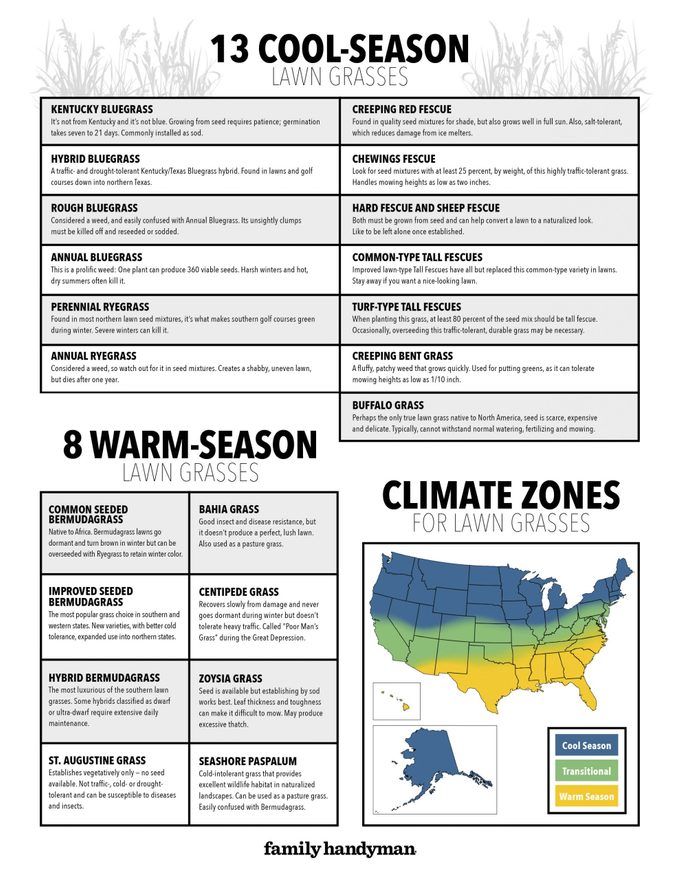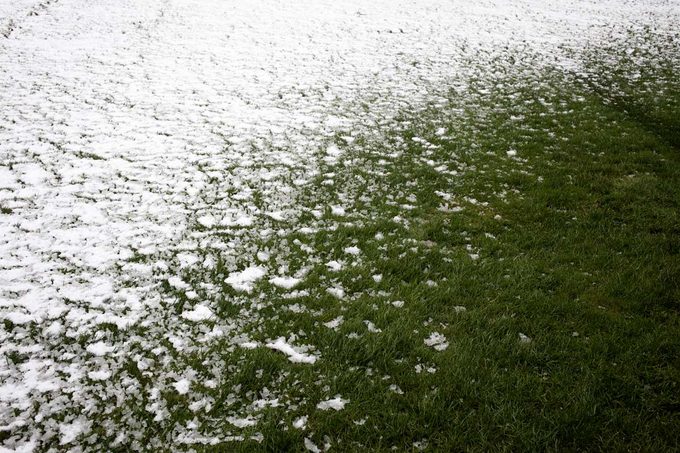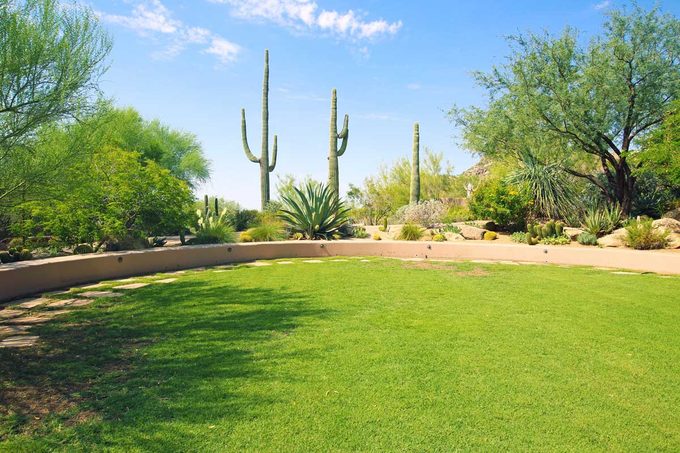Top 21 Turf Grasses and How To ID Them | The Family Handyman
Get to know the most common turf grasses you'll see in lawns, ballfields and parks beyond the U.S., and discover which one would work all-time in your yard.
When you choose the best grass for your climate, conditions and lifestyle, yous greatly improve your chances of growing the lawn you've ever wanted.
A Cursory Glossary of Grass Terms
Cool-season grass: Grows best in Northern climates, college elevations and other temperate regions where winters are cold and summers are balmy.
Warm-flavor grass: Grows all-time in Southern and Southwestern climates where ambience temperatures seldom, if ever, dip below freezing. Thrives in warm, boiling conditions.
Tillers: Singular vegetative shoots originating from the base of a "mother" grass plant consisting of a stalk and leaf blades.
Rhizomes: Underground stems that help some grasses spread.
Stolons: Aboveground runners or lateral stems that help some grasses spread.
Bunch type: Grasses that grow from tillers that sprout from the base of an private grass plant.

Download the PDF version of this chart.
13 Absurd-Season Lawn Grasses

Kentucky Bluegrass (Poa pratensis)
ID It: Medium- to night-light-green color; medium texture; boat-shaped leaf tip; spreads by rhizomes.
Where Y'all'll Discover Information technology: Most everywhere north of Interstate 80, preferring mild summers, cold winters and full sun.
Why Plant It: Because this durable, winter hardy grass recovers chop-chop from drought and vesture damage. It is uniform with other cool-season grasses and speedily forms a tightly knit sod.
What to Know: It did not originate in Kentucky (information technology'due south native to Europe) and it's not blue. Primarily grown from seed, which requires patience considering germination takes 7 to 21 days. It is commonly installed equally sod.
Hybrid Bluegrass (Poa arachnifera x Poa pratensis)
ID It: Dark-light-green color; medium-fine leaf texture; boat-shaped leaf tip; spreads by rhizomes.
Where Yous'll Notice Information technology: Mostly in the transition zone, preferring hot, dry, shady conditions.
Why Plant It: Because its deep-penetrating root organization provides improved estrus and drought tolerance in Northern lawns.
What to Know: This is a hybrid cross of Kentucky Bluegrass and Texas Bluegrass, often found blended with turf-type alpine fescue seed. You'll find traffic tolerant Hybrid Bluegrass lawns and golf courses all the way down into northern Texas.
Rough Bluegrass (Poa trivialis)
ID Information technology: Light-green colour; soft leafage blades; spreads by stolons; frequently shows up in lawns as unsightly clumps.
Where You'll Find It: In U.S. regions that stay cool and wet and shady over-watered lawns.
Why Plant Information technology: Don't! Establish simply as a last resort for moderate shade in moist locations.
What to Know: Generally considered a weed, some seed companies however use it in shade grass mixtures. There is no known selective command, so patches, which are easy to confuse with Annual Bluegrass, must be killed off and reseeded or sodded.
Annual Bluegrass (Poa annua)
ID Information technology: Appears as apple tree-green patches of all sizes; ofttimes displays whitish seedheads; bunch-blazon grass.
Where Yous'll Find It: Everywhere. Information technology's on all seven continents and is 1 of the top five most common plants on World, preferring moist, cool areas and heavy soils. You'll see information technology in most golf courses and residential lawns that receive lots of fertilizer and water.
Why Plant It: Don't. Information technology's a weed.
What to Know: Don't buy cheap grass seed considering information technology probably contains Annual Bluegrass. Sometimes confused with Rough Bluegrass and all Bentgrasses, 1 plant of this prolific seeder can produce 360 viable seeds. Harsh winters and hot, dry summers will often kill it.
Perennial Ryegrass (Lolium perenne)
ID It: Medium-green colour; shiny underside of leaf blades; bunch-type growth.
Where You'll Find It: Sunny locations, especially in Southern states where information technology's used every bit a temporary winter grass.
Why Plant It: Because it is fast to establish and has improved clothing tolerance.
What to Know: Perennial Ryegrass, which looks like Kentucky Bluegrass, is found in most Northern backyard seed mixtures. It's widely used on golf courses and brawl fields; it'due south what makes Southern golf game courses light-green during the winter. Notation that extremely severe winters can kill it.
Annual Ryegrass (Lolium multiflorum)
ID It: Apple-dark-green color; coarse texture; germinates and grows faster than other grasses; bunch-type growth.
Where You'll Observe Information technology: Throughout the U.S., often in pastures.
Why Found It: Because it's cheap and you don't care how your lawn looks. Annual Ryegrass is likewise good as a nurse crop to protect slower-growing grasses as they establish, and where temporary groundcover is desired.
What to Know: It'southward pretty much a weed, so resist using seed mixtures containing information technology. It grows much faster and taller than other grasses and creates a shabby, uneven lawn. Luckily, it simply grows for one year and and so dies.
Creeping Scarlet Fescue (Festuca rubra ssp. rubra)
ID It: Medium-greenish color; extremely fine texture; spreads past rhizomes; grows slowly once established.
Where Yous'll Find It: Throughout the Northern U.S. at shady roadside and utility areas with infertile, sandy soil, and in depression-maintenance lawns.
Why Plant It: Considering you want to expand the overall multifariousness of your medium- to heavily shaded lawn, especially if you lot're trying to cut back on fertilizer and water use.
What to Know: You volition find creeping red fescue in quality seed mixtures for shade, but it grows surprisingly well in full sun equally well. It grows well with other Northern grasses and is common salt-tolerant, which helps limit turf damage from water ice melters.
Chewings Fescue (Festuca rubra ssp. commutata)
ID It: Medium- to nighttime-greenish color; extremely fine texture; very skilful turf density; bunch-type growth habit.
Where You'll Find It: Throughout the Northern U.S., in well-maintained lawns with well-drained soil with full dominicus to heavy shade.
Why Found Information technology: Because you want to expand genetic diversity, improve lawn density and reduce weeds in your shady backyard.
What to Know: Wait for seed mixtures with at least 25 percent by weight of this highly traffic-tolerant fine fescue. It grows well with Kentucky Bluegrass and can handle mowing heights as depression as two inches.
Hard Fescue (Festuca trachyphylla) (Festuca ovina var.)
ID Information technology: Medium-dark to bluish-green leaf color; very fine texture; can get clumpy in low-maintenance lawns; bunch-type growth addiction.
Where Y'all'll Notice Them: Throughout the Northern U.S., in cemeteries, old parks, naturalized areas, roadsides and other no-mow areas with total sun to heavy shade.
Why Plant Them: Because these grasses can help convert a backyard to a naturalized look and are perfect if y'all don't desire to h2o, fertilize or even mow your lawn.
What to Know: They're not for anybody. You'll have to grow from seed because yous won't find these grasses as sod. Some have a unique look due to a fine leaf texture and blueish-light-green color. One time established, they like to be left lone.
Common-Type Alpine Fescues (Festuca arundinacea)
ID It: Coarse, weed-like appearance; rigid leaf blades; agglomeration-type growth.
Where You'll Detect Them: Throughout the Transition Zone in pastures, native areas, roadsides, old lawns, parks and common grounds.
Why Institute Information technology: Because this grass is less expensive than turf-type tall fescue, if turf quality and density isn't important, you lot'll salve money.
What to Know: Stay abroad if yous want a nice-looking lawn. Improved "backyard-type" tall fescues have all but replaced the "mutual-type" variety in lawns. These grasses are not winter hardy and should not exist used in Northern states. Some named varieties are K31, Alta and Fawn.
Turf-Type Tall Fescues (Schedonorus arundinaceus)
ID It: Nighttime-dark-green colour; medium-textured with rigid, pointy leaves; deep, penetrating root organization; agglomeration-type growth.
Where You'll Notice Them: Throughout the transition zone in actively used, depression to moderately maintained lawns, playgrounds and ball fields with total sunday to moderate shade and all soil types.
Why Plant Them: Because y'all want a take-it-easy backyard requiring less fertilizer and water, but traffic tolerance and immovability are important.
What to Know: To grow this grass, at least lxxx percent of the seed mix by weight should exist tall fescue. You may need to overseed occasionally to maintain density. They tin can be slow to recover from article of clothing. New varieties are meliorate adapted to extreme Northern winters, and virtually comprise the benign mucus endophyte that improves resistance to lawn insects.
Creeping Bentgrass (Agrostis stolonifera)
ID Information technology: Olive to lighter green color; very fine texture; soft, velvety impact; spreads past stolons.
Where You lot'll Find It: Mostly in the Northern two-thirds of U.S. states, in more often than not sunny areas with well-drained, lighter soils, especially golf courses and bowling lawns.
Why Plant Information technology: Because y'all desire a domicile putting light-green and you're up for a challenge. It has express application for residential lawns.
What to Know: It shows up as a fluffy, patchy weed that grows quickly and can exist confused with Rough Bluegrass and Annual Bluegrass. It can tolerate mowing heights as low equally 1/10-inch on putting greens.
Buffalograss (Buchloe dactyloides)
ID It: Grayish-greenish color; medium to fine-textured leaves; open, thin turf density; spreads by stolons.
Where You'll Find It: Throughout the Canadian plains to southern Texas where it's dry, with limited rainfall and full sunday, in native, passively used lawns and general turf areas.
Why Plant It: Because yous desire a native, low-maintenance lawn so y'all don't have to apply fertilizer, water and pesticides.
What to Know: Seed for this, perhaps the just true lawn grass native to Due north America, is difficult to find and expensive. While tolerant of many environmental atmospheric condition, Buffalograss can be easily squeezed out by more ambitious backyard grasses. Normal watering, fertilizing and mowing can exist as well much for it.
8 Warm-Season Lawn Grasses

Common Seeded Bermudagrass (Cynodon dactylon)
ID It: Dull, lite-green colour; medium leaf texture; loosely netted, lacks density; spreads by rhizomes and stolons.
Where You lot'll Find It: In full-sun native grass areas, roadsides and older Southern lawns.
Why Plant Information technology: Considering turf quality isn't of import and you desire to save coin.
What to Know: Oddly, Bermudagrass is native to Africa, not Bermuda. Bermudagrass lawns go dormant and plough brown during winter and can be overseeded with Ryegrass to retain winter color.
Improved Seeded Bermudagrass (Cynodon dactylon)
ID It: Darker green color; medium leafage texture; superior turf density vs. mutual types; deeper penetrating roots.
Where You'll Find It: Wherever there is full sun and better lawn quality is desired, such every bit well-maintained ball fields, golf courses, parks and residential lawns.
Why Establish It: Because you desire better-looking grass that's resistant to disease and insects, traffic-tolerant and cold hardy.
What to Know: Bermudagrass is the most popular grass pick in Southern and Western states. New varieties, with much better cold tolerance, take expanded its utilise into Northern states. It is sometimes confused with crabgrass considering its leaves and seed heads wait like. The first Improved Seeded Bermudagrass was Guymon, released in 1987.
Hybrid Bermudagrass (C. dactylon ten C. transvaalensis)
ID It: Dark-green colour; superior turf density; fast-growing; spreads past stolons and rhizomes.
Where Y'all'll Notice Information technology: In Southern golf course putting greens, high-stop academy and professional ball fields, elite lawns and commercial properties with full sun.
Why Found It: Because y'all want superior turf quality, traffic tolerance, speed of recovery and turf density so you tin have the finest looking lawn in the neighborhood.
What to Know: This is the luxury car of Southern lawn grasses. Some hybrids are classified as dwarf or ultra-dwarf, but they require extensive daily maintenance.
St. Augustinegrass (Stenotaphrum secundatum)
ID It: Medium- to dark-green color; very wide, apartment leaf blades with blunt, rounded tips; spreads by stolons.
Where You'll Discover It: Humid and tropical regions from Florida's Atlantic Coast to the Texas Gulf Coast, in well-maintained areas including lawns, parks and commercial properties with full dominicus to moderate shade.
Why Found It: Because you take a moderately depression-maintenance site in a hot, boiling location with some shade.
What to Know: This grass, native to the Gulf Coast, West Indies and Western Africa, establishes vegetatively — no seed is bachelor. It'south not traffic-, cold- or drought-tolerant and it tin exist susceptible to diseases and insects.
Bahiagrass (Paspalum notatum)
ID It: Nighttime green colour; medium-fibroid leaf texture; deep root system; ho-hum to institute from seed; tedious growing; spreads past weak stolons.
Where You'll Find It: Throughout Florida's Atlantic Coast to the Texas Gulf Coast, and in hot, dry out regions where in that location is full sun to lite shade.
Why Plant Information technology: You lot live in a hot, dry region with limited access to water, and/or your soil is heavy and drains poorly, and you want an easy-care lawn.
What to Know: Bahiagrass is also used as a pasture grass and it tin can produce unsightly seed heads. There are some new lawn-blazon varieties bachelor, and it has good insect and disease resistance. However, it'southward non for those who want a perfect, lush lawn.
Centipedegrass (Due east remochloa ophiuroides)
ID Information technology: Light apple-green color; medium-coarse texture; shallow root organisation; spreads by stolons.
Where You'll Find It: Throughout the Florida Atlantic Coast to the Texas Gulf Coast in low-maintenance lawns where water is plentiful, the soil is sandy and acidic and there is total lord's day to calorie-free shade.
Why Found Information technology: Because you want to mow less and your soil is actually sandy and infertile.
What to Know: Centipedegrass is native to China and Southeast Asia. During the Great Low, it was referred to as "Poor Man's Grass." It doesn't tolerate heavy traffic, recovers slowly from impairment and never goes fallow during the winter.
Zoysiagrass (Zoysia japonica)
ID It: Light- to medium-green colour; medium to coarse leaf texture; forms dense sod; deep penetrating root organisation; spreads by rhizomes and stolons.
Where You'll Detect Information technology: Throughout the hot, dry areas of the transition zone and West Coast in well-maintained lawns and commercial properties with full sun to light shade.
Why Plant Information technology: Because you want quality estrus- and cold-tolerant turf for your actively used lawn.
What to Know: Native to Asia, seed is bachelor, simply establishing by sod works best. Leaf thickness and toughness can get in difficult to mow. Information technology tin can produce excessive thatch, requiring occasional dethatching.
Seashore Paspalum (Paspalum vaginatum)
ID It: Medium green; medium to coarse foliage texture; spreads by both rhizomes and stolons.
Where Y'all'll Detect Information technology: Throughout the Gulf Coast and other salty areas in residential lawns, ball fields and golf game courses with total sun to medium shade and adequate wet.
Why Establish It: Because you want an elite-quality backyard that will tolerate low mowing and heavy employ, even though your soil and irrigation water source has a high salt concentration.
What to Know: Seed is not bachelor, so this common cold-intolerant grass is established vegetatively past sod or stolons. It provides splendid wildlife habitat in naturalized landscapes, can be used equally a pasture grass and tin can be dislocated with Bermudagrass.
ocegueraforemary57.blogspot.com
Source: https://www.familyhandyman.com/article/turf-grass/
Post a Comment for "Top 21 Turf Grasses and How To ID Them | The Family Handyman"